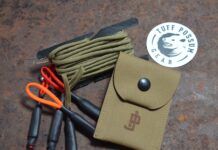I wrote about the M16 the other day and how it still represented an impressively capable rifle in today’s field of 5.56 caliber options. Well, today I’m going to jump behind the Iron Curtain and reference Ian from Forgotten Weapons and Josh and Henry with 9-Hole reviews and talk about the unsung long serving hero the Cold War Eastern European service rifles.
We all know the AK-47, we know the AKM, they are certainly the most prolific examples of a service rifle remaining around the world in use. However… The Soviet Union developed beyond AKM way back in 1974 with the AK-74 and later M variants of the 5.45x39mm service rifle. They changed caliber and made a new rifle on a similar system. This would be comparable to the US using the AR-10 instead of the M-14 and then going to the AR-15. It is less of a radical departure, but still a new rifle.
Czechoslovakia semi-famously went ‘Cold War Hipster’ in 1958 and did their own thing with the 7.62×39 round mandated by the Warsaw Pact. Unlike all those who just licensed an AK, their VZ 58 rifle was a completely different and well regarded system with a visual similarity. It’s like thinking you recognize someone because of a side profile. The only true similarities are the curvature of the VZ’s and AK magazines (because same ammo), the laminate wood type material used for both rifle’s stocks and handguards, and the iron sight style.
Unlike the AK-47/AKM which was supplanted by the 74 and newer rifles today, the VZ sat pretty much unchanged until 2011. The outlasted the Soviet Union and the splitting of its home nation into two nations who are both finally starting to retire it for the 805 and Bren 2. Look at how many AK revisions we’ve had in the interim while the VZ just kept doing its thing and working.
The VZ 58 operation is ‘almost’ striker fired in its design. The trigger mechanism contains sear control surfaces that wouldn’t be out of place in a Glock or P320. In actuality, as Ian explains in the first video, is a linear spring loaded hammer that still hits a separate firing pin in the bolt. A true ‘striker’ would have the firing pin attached to the spring loaded firing mechanism like you see in striker pistols. The VZ also doesn’t use the otherwise popular rotating bolt carrier designs and instead has a locking block the drops vertically into place when the carrier is forward. It operates on a short stroke has piston instead of a full stroke.
The weapon is brilliantly simple and elegant in a way that reminds me of German roller-delay systems, despite being far more closely related to rotating bolt and piston operated guns.
I can see why it was so slow to be shed as a service rifle too. They just worked and were in service with nations that weren’t quick at adopting a lot of the gadgets and gizmos we use on our rifles. A modernization of the VZ would be utterly simple. Add an ambidextrous selector, add a modernized fore end for ancillaries and an adjustable holding stock, standardize on the side receiver mount for optics and a Ultimak type gas tube rail, and conduct a materials study to see if anything could be updated to a better metal or polymer. Very basic. I wouldn’t even necessarily change calibers since effective 7.62×39 rounds are plentiful and it’s a pretty nice cartridge to run in shorter barrels and suppressed.
But we’re about to reinvent the battle rifle so we will see how Europe follows suit.



